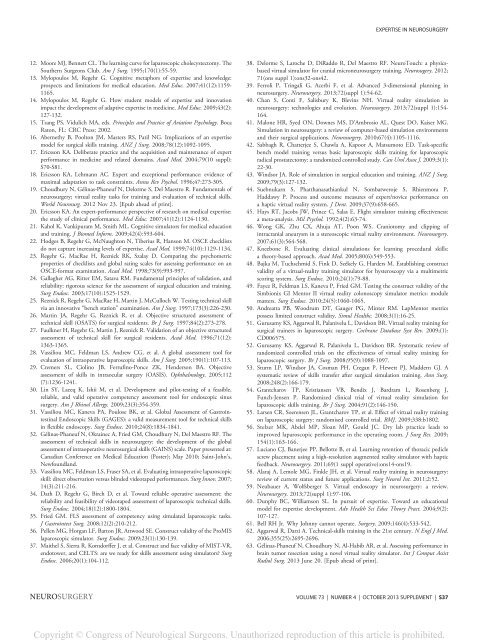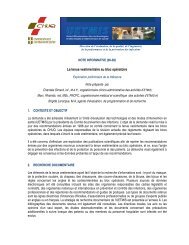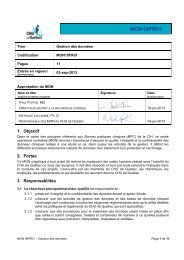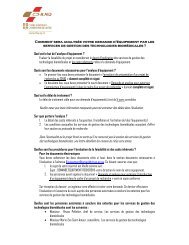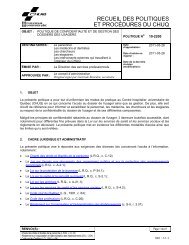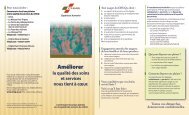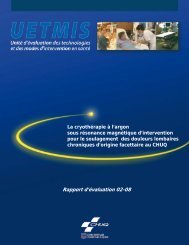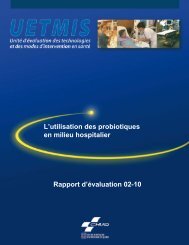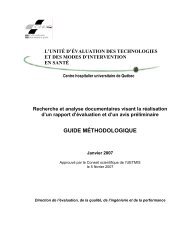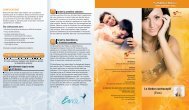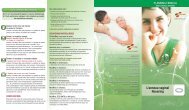Surgical Expertise in Neurosurgery: Integrating Theory Into ... - CHUQ
Surgical Expertise in Neurosurgery: Integrating Theory Into ... - CHUQ
Surgical Expertise in Neurosurgery: Integrating Theory Into ... - CHUQ
Create successful ePaper yourself
Turn your PDF publications into a flip-book with our unique Google optimized e-Paper software.
Copyright © Congress of Neurological Surgeons. Unauthorized reproduction of this article is prohibited.EXPERTISE IN NEUROSURGERY12. Moore MJ, Bennett CL. The learn<strong>in</strong>g curve for laparoscopic cholecystectomy. TheSouthern Surgeons Club. Am J Surg. 1995;170(1):55-59.13. Mylopoulos M, Regehr G. Cognitive metaphors of expertise and knowledge:prospects and limitations for medical education. Med Educ. 2007;41(12):1159-1165.14. Mylopoulos M, Regehr G. How student models of expertise and <strong>in</strong>novationimpact the development of adaptive expertise <strong>in</strong> medic<strong>in</strong>e. Med Educ. 2009;43(2):127-132.15. Tsang PS, Vidulich MA, eds. Pr<strong>in</strong>ciples and Practice of Aviation Psychology. BocaRaton, FL: CRC Press; 2002.16. Abernethy B, Poolton JM, Masters RS, Patil NG. Implications of an expertisemodel for surgical skills tra<strong>in</strong><strong>in</strong>g. ANZ J Surg. 2008;78(12):1092-1095.17. Ericsson KA. Deliberate practice and the acquisition and ma<strong>in</strong>tenance of expertperformance <strong>in</strong> medic<strong>in</strong>e and related doma<strong>in</strong>s. Acad Med. 2004;79(10 suppl):S70-S81.18. Ericsson KA, Lehmann AC. Expert and exceptional performance: evidence ofmaximal adaptation to task constra<strong>in</strong>ts. Annu Rev Psychol. 1996;47:273-305.19. Choudhury N, Gél<strong>in</strong>as-Phaneuf N, Delorme S, Del Maestro R. Fundamentals ofneurosurgery; virtual reality tasks for tra<strong>in</strong><strong>in</strong>g and evaluation of technical skills.World Neurosurg. 2012 Nov 23. [Epub ahead of pr<strong>in</strong>t].20. Ericsson KA. An expert-performance perspective of research on medical expertise:the study of cl<strong>in</strong>ical performance. Med Educ. 2007;41(12):1124-1130.21. Kahol K, Vankipuram M, Smith ML. Cognitive simulators for medical educationand tra<strong>in</strong><strong>in</strong>g. J Biomed Inform. 2009;42(4):593-604.22. Hodges B, Regehr G, McNaughton N, Tiberius R, Hanson M. OSCE checklistsdo not capture <strong>in</strong>creas<strong>in</strong>g levels of expertise. Acad Med. 1999;74(10):1129-1134.23. Regehr G, MacRae H, Reznick RK, Szalay D. Compar<strong>in</strong>g the psychometricproperties of checklists and global rat<strong>in</strong>g scales for assess<strong>in</strong>g performance on anOSCE-format exam<strong>in</strong>ation. Acad Med. 1998;73(9):993-997.24. Gallagher AG, Ritter EM, Satava RM. Fundamental pr<strong>in</strong>ciples of validation, andreliability: rigorous science for the assessment of surgical education and tra<strong>in</strong><strong>in</strong>g.Surg Endosc. 2003;17(10):1525-1529.25. Reznick R, Regehr G, MacRae H, Mart<strong>in</strong> J, McCulloch W. Test<strong>in</strong>g technical skillvia an <strong>in</strong>novative “bench station” exam<strong>in</strong>ation. Am J Surg. 1997;173(3):226-230.26. Mart<strong>in</strong> JA, Regehr G, Reznick R, et al. Objective structured assessment oftechnical skill (OSATS) for surgical residents. Br J Surg. 1997;84(2):273-278.27. Faulkner H, Regehr G, Mart<strong>in</strong> J, Reznick R. Validation of an objective structuredassessment of technical skill for surgical residents. Acad Med. 1996;71(12):1363-1365.28. Vassiliou MC, Feldman LS, Andrew CG, et al. A global assessment tool forevaluation of <strong>in</strong>traoperative laparoscopic skills. Am J Surg. 2005;190(1):107-113.29. Cremers SL, Ciol<strong>in</strong>o JB, Ferruf<strong>in</strong>o-Ponce ZK, Henderson BA. Objectiveassessment of skills <strong>in</strong> <strong>in</strong>traocular surgery (OASIS). Ophthalmology. 2005;112(7):1236-1241.30. L<strong>in</strong> SY, Laeeq K, Ishii M, et al. Development and pilot-test<strong>in</strong>g of a feasible,reliable, and valid operative competency assessment tool for endoscopic s<strong>in</strong>ussurgery. Am J Rh<strong>in</strong>ol Allergy. 2009;23(3):354-359.31. Vassiliou MC, Kaneva PA, Poulose BK, et al. Global Assessment of Gastro<strong>in</strong>test<strong>in</strong>alEndoscopic Skills (GAGES): a valid measurement tool for technical skills<strong>in</strong> flexible endoscopy. Surg Endosc. 2010;24(8):1834-1841.32. Gél<strong>in</strong>as-Phaneuf N, Okra<strong>in</strong>ec A, Fried GM, Choudhury N, Del Maestro RF. Theassessment of technical skills <strong>in</strong> neurosurgery: the development of the globalassessment of <strong>in</strong>traoperative neurosurgical skills (GAINS) scale. Paper presented at:Canadian Conference on Medical Education (Poster); May 2010; Sa<strong>in</strong>t-John’s,Newfoundland.33. Vassiliou MC, Feldman LS, Fraser SA, et al. Evaluat<strong>in</strong>g <strong>in</strong>traoperative laparoscopicskill: direct observation versus bl<strong>in</strong>ded videotaped performances. Surg Innov. 2007;14(3):211-216.34. Dath D, Regehr G, Birch D, et al. Toward reliable operative assessment: thereliability and feasibility of videotaped assessment of laparoscopic technical skills.Surg Endosc. 2004;18(12):1800-1804.35. Fried GM. FLS assessment of competency us<strong>in</strong>g simulated laparoscopic tasks.J Gastro<strong>in</strong>test Surg. 2008;12(2):210-212.36. Pellen MG, Horgan LF, Barton JR, Attwood SE. Construct validity of the ProMISlaparoscopic simulator. Surg Endosc. 2009;23(1):130-139.37. Maithel S, Sierra R, Korndorffer J, et al. Construct and face validity of MIST-VR,endotower, and CELTS: are we ready for skills assessment us<strong>in</strong>g simulators? SurgEndosc. 2006;20(1):104-112.38. Delorme S, Laroche D, DiRaddo R, Del Maestro RF. NeuroTouch: a physicsbasedvirtual simulator for cranial microneurosurgery tra<strong>in</strong><strong>in</strong>g. Neurosugery. 2012;71(ons suppl 1):ons32-ons42.39. Ferroli P, Tr<strong>in</strong>gali G, Acerbi F, et al. Advanced 3-dimensional plann<strong>in</strong>g <strong>in</strong>neurosurgery. <strong>Neurosurgery</strong>. 2013;72(suppl 1):54-62.40. Chan S, Conti F, Salisbury K, Blev<strong>in</strong>s NH. Virtual reality simulation <strong>in</strong>neurosurgery: technologies and evolution. <strong>Neurosurgery</strong>. 2013;72(suppl 1):154-164.41. Malone HR, Syed ON, Downes MS, D’Ambrosio AL, Quest DO, Kaiser MG.Simulation <strong>in</strong> neurosurgery: a review of computer-based simulation environmentsand their surgical applications. <strong>Neurosurgery</strong>. 2010;67(4):1105-1116.42. Sabbagh R, Chatterjee S, Chawla A, Kapoor A, Matsumoto ED. Task-specificbench model tra<strong>in</strong><strong>in</strong>g versus basic laparoscopic skills tra<strong>in</strong><strong>in</strong>g for laparoscopicradical prostatectomy: a randomized controlled study. Can Urol Assoc J. 2009;3(1):22-30.43. W<strong>in</strong>dsor JA. Role of simulation <strong>in</strong> surgical education and tra<strong>in</strong><strong>in</strong>g. ANZ J Surg.2009;79(3):127-132.44. Suebnukarn S, Phatthanasathiankul N, Sombatweroje S, Rhienmora P,Haddawy P. Process and outcome measures of expert/novice performance ona haptic virtual reality system. J Dent. 2009;37(9):658-665.45. Hays RT, Jacobs JW, Pr<strong>in</strong>ce C, Salas E. Flight simulator tra<strong>in</strong><strong>in</strong>g effectiveness:a meta-analysis. Mil Psychol. 1992;4(2):63-74.46. Wong GK, Zhu CX, Ahuja AT, Poon WS. Craniotomy and clipp<strong>in</strong>g of<strong>in</strong>tracranial aneurysm <strong>in</strong> a stereoscopic virtual reality environment. <strong>Neurosurgery</strong>.2007;61(3):564-568.47. Kneebone R. Evaluat<strong>in</strong>g cl<strong>in</strong>ical simulations for learn<strong>in</strong>g procedural skills:a theory-based approach. Acad Med. 2005;80(6):549-553.48. Bajka M, Tuchschmid S, F<strong>in</strong>k D, Székely G, Harders M. Establish<strong>in</strong>g constructvalidity of a virtual-reality tra<strong>in</strong><strong>in</strong>g simulator for hysteroscopy via a multimetricscor<strong>in</strong>g system. Surg Endosc. 2010;24(1):79-88.49. Fayez R, Feldman LS, Kaneva P, Fried GM. Test<strong>in</strong>g the construct validity of theSimbionix GI Mentor II virtual reality colonoscopy simulator metrics: modulematters. Surg Endosc. 2010;24(5):1060-1065.50. Andreatta PB, Woodrum DT, Gauger PG, M<strong>in</strong>ter RM. LapMentor metricspossess limited construct validity. Simul Healthc. 2008;3(1):16-25.51. Gurusamy KS, Aggarwal R, Palanivelu L, Davidson BR. Virtual reality tra<strong>in</strong><strong>in</strong>g forsurgical tra<strong>in</strong>ees <strong>in</strong> laparoscopic surgery. Cochrane Database Syst Rev. 2009;(1):CD006575.52. Gurusamy KS, Aggarwal R, Palanivelu L, Davidson BR. Systematic review ofrandomized controlled trials on the effectiveness of virtual reality tra<strong>in</strong><strong>in</strong>g forlaparoscopic surgery. Br J Surg. 2008;95(9):1088-1097.53. Sturm LP, W<strong>in</strong>dsor JA, Cosman PH, Cregan P, Hewett PJ, Maddern GJ. Asystematic review of skills transfer after surgical simulation tra<strong>in</strong><strong>in</strong>g. Ann Surg.2008;248(2):166-179.54. Grantcharov TP, Kristiansen VB, Bendix J, Bardram L, Rosenberg J,Funch-Jensen P. Randomized cl<strong>in</strong>ical trial of virtual reality simulation forlaparoscopic skills tra<strong>in</strong><strong>in</strong>g. Br J Surg. 2004;91(2):146-150.55. Larsen CR, Soerensen JL, Grantcharov TP, et al. Effect of virtual reality tra<strong>in</strong><strong>in</strong>gon laparoscopic surgery: randomised controlled trial. BMJ. 2009;338:b1802.56. Stelzer MK, Abdel MP, Sloan MP, Gould JC. Dry lab practice leads toimproved laparoscopic performance <strong>in</strong> the operat<strong>in</strong>g room. JSurgRes.2009;154(1):163-166.57. Luciano CJ, Banerjee PP, Bellotte B, et al. Learn<strong>in</strong>g retention of thoracic pediclescrew placement us<strong>in</strong>g a high-resolution augmented reality simulator with hapticfeedback. <strong>Neurosurgery</strong>. 2011;69(1 suppl operative):ons14-ons19.58. Alaraj A, Lemole MG, F<strong>in</strong>kle JH, et al. Virtual reality tra<strong>in</strong><strong>in</strong>g <strong>in</strong> neurosurgery:review of current status and future applications. Surg Neurol Int. 2011;2:52.59. Neubauer A, Wolfsberger S. Virtual endoscopy <strong>in</strong> neurosurgery: a review.<strong>Neurosurgery</strong>. 2013;72(suppl 1):97-106.60. Dunphy BC, Williamson SL. In pursuit of expertise. Toward an educationalmodel for expertise development. Adv Health Sci Educ <strong>Theory</strong> Pract. 2004;9(2):107-127.61. Bell RH Jr. Why Johnny cannot operate. Surgery. 2009;146(4):533-542.62. Aggarwal R, Darzi A. Technical-skills tra<strong>in</strong><strong>in</strong>g <strong>in</strong> the 21st century. N Engl J Med.2006;355(25):2695-2696.63. Gél<strong>in</strong>as-Phaneuf N, Choudhury N, Al-Habib AR, et al. Assess<strong>in</strong>g performance <strong>in</strong>bra<strong>in</strong> tumor resection us<strong>in</strong>g a novel virtual reality simulator. Int J Comput AssistRadiol Surg. 2013 June 20. [Epub ahead of pr<strong>in</strong>t].NEUROSURGERYVOLUME 73 | NUMBER 4 | OCTOBER 2013 SUPPLEMENT | S37


